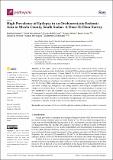| dc.contributor.author | Raimon, Stephen | |
| dc.contributor.author | Dusabimana, Alfred | |
| dc.contributor.author | Abd-Elfarag, Gasim | |
| dc.contributor.author | Okaro, Samuel | |
| dc.contributor.author | Carter, Jane Y. | |
| dc.contributor.author | Newton, Charles R. | |
| dc.contributor.author | Logora, Makoy Yibi | |
| dc.contributor.author | Colebunders, Robert | |
| dc.date.accessioned | 2021-09-10T20:25:03Z | |
| dc.date.available | 2021-09-10T20:25:03Z | |
| dc.date.issued | 5/14/2021 | |
| dc.identifier.citation | Raimon, S.; Dusabimana, A.; Abd-Elfarag, G.; Okaro, S.; Carter, J.Y.; Newton, C.R.; Logora, M.Y.; Colebunders, R. High Prevalence of Epilepsy in an Onchocerciasis-Endemic Area in Mvolo County, South Sudan: A Door-To-Door Survey. Pathogens 2021, 10, 599. https://doi.org/10.3390/ pathogens10050599ton CR, Logora MY, Colebunders R. High Prevalence of Epilepsy in an Onchocerciasis-Endemic Area in Mvolo County, South Sudan: A Door-To-Door Survey. Pathogens. 2021 May 14;10(5):599. doi: 10.3390/pathogens10050599. PMID: 34068976; PMCID: PMC8157079. | en_US |
| dc.identifier.other | PMID: 34068976 | |
| dc.identifier.other | PMCID: PMC8157079 | |
| dc.identifier.other | DOI: 10.3390/pathogens10050599 | |
| dc.identifier.uri | http://repository.amref.org/handle/123456789/237 | |
| dc.description | t: © 2021 by the authors.
Licensee MDPI, Basel, Switzerland.
This article is an open access article
distributed under the terms and
conditions of the Creative Commons
Attribution (CC BY) license (https://
creativecommons.org/licenses/by/
4.0/). | en_US |
| dc.description.abstract | In June 2020, a door-to-door household survey was conducted in Mvolo County, an onchocerciasis-endemic area in South Sudan. A total of 2357 households containing 15,699 individuals agreed to participate in the study. Of these, 5046 (32.1%, 95% CI: 31.4-32.9%) had skin itching and 445 (2.8%, 95% CI: 2.6-3.1%) were blind. An epilepsy screening questionnaire identified 813 (5.1%) persons suspected of having epilepsy. Of them, 804 (98.9%) were seen by a medical doctor, and in 798 (98.1%) the diagnosis of epilepsy was confirmed. The overall epilepsy prevalence was 50.8/1000 (95% CI: 47.6-54.4/1000), while the prevalence of nodding syndrome was 22.4/1000 (95% CI: 20.1-24.9/1000). Younger age, being male, skin itching, blindness, and living in a neighbourhood or village close to the Naam River were risk factors for epilepsy. The annual incidence of epilepsy was 82.8/100,000 (95% CI: 44.1-141.6/100,000). Among children 7-9 years old without epilepsy, 34% were Ov16 seropositive, suggesting high ongoing Onchocerca volvulus transmission, but only 41.9% of them took ivermectin during the last mass distribution. In conclusion, a high prevalence and incidence of epilepsy was observed in Mvolo, South Sudan. Strengthening of the onchocerciasis elimination programme is urgently needed in order to prevent epilepsy in this region. | en_US |
| dc.description.sponsorship | R2HC grant of Amref South Sudan (Project ID: 40385) and the
European Research Council (ERC 671055) | en_US |
| dc.language.iso | en | en_US |
| dc.publisher | MDPI | en_US |
| dc.subject | Onchocerca volvulus | en_US |
| dc.subject | Epilepsy | en_US |
| dc.subject | Ivermectin | en_US |
| dc.subject | Nodding syndrome | en_US |
| dc.subject | Onchocerciasis | en_US |
| dc.subject | Prevalence | en_US |
| dc.title | High Prevalence of Epilepsy in an Onchocerciasis-Endemic Area in Mvolo County, South Sudan: A Door-To-Door Survey | en_US |
| dc.type | Article, Journal | en_US |

